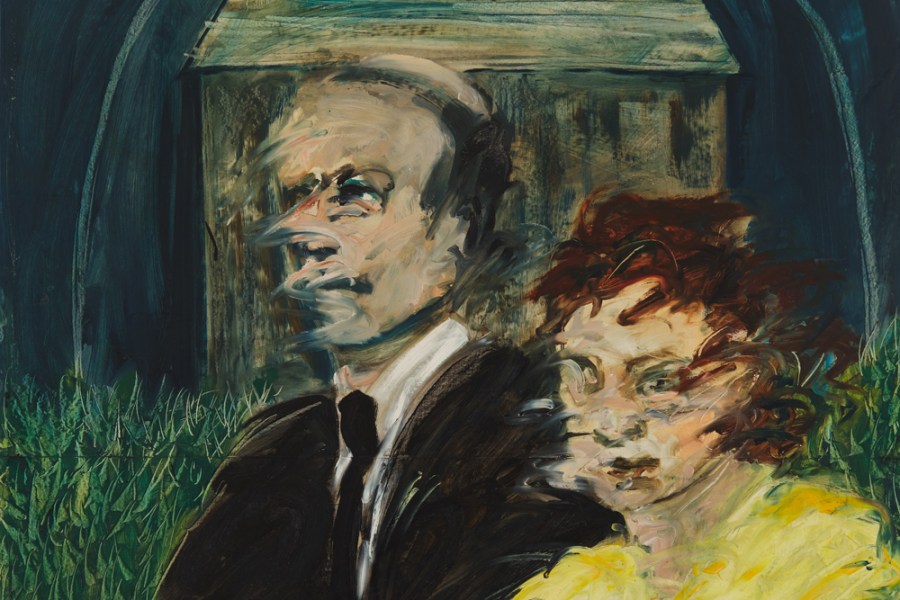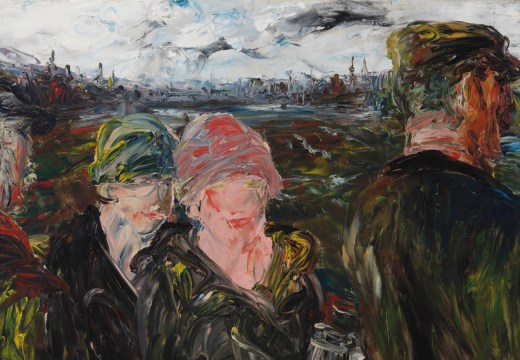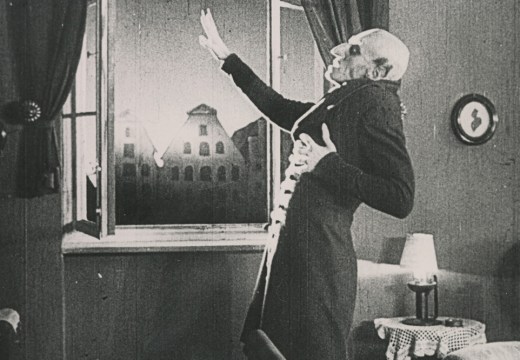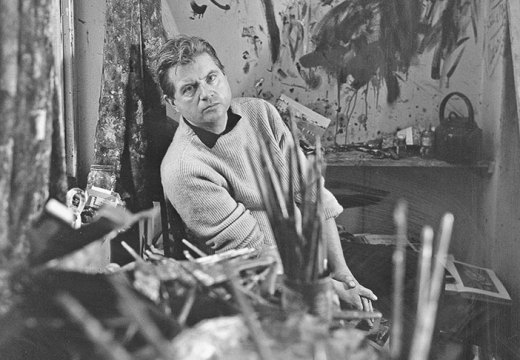For more than a couple of hundred years, Ireland has been culturally identified as a gothic space. Historically, much of this was a question of England thinking of itself as enlightened or modern by banishing to the Celtic periphery what it wished to deny: the irrational, the backward, the Catholic. Irish culture in turn took on, rather than merely rejected, a sense of itself as a strange, haunted place. More recently, this has included reckoning with the legacies of what was, in the south of Ireland, a near theocratic post-independence state.
In her first retrospective, drawing together more than 80 works produced during the past four decades, Patricia Hurl emerges as a powerful artistic witness to the misogyny of modern Irish society. The exhibition’s title, ‘Irish Gothic’, is shared by several of her large early oils. However, her translation of the aesthetics of the gothic into paint involves no ghouls or vampires. Disturbing enough is the actuality that her work evokes.

Study for The Kerry Babies Trial (1984), Patricia Hurl. Irish Museum of Modern Art; © the artist
Two of the early paintings, Ministry of Fear (1986) and Act of Union (Once upon a Time) (1986), share a resemblance. Both look somewhat like family photos. One records a young girl’s first communion, the other a woman on her wedding day. Standing behind and just to the right of both white-clad females is the black besuited figure of what appear to be their respective fathers. Both are framed within architectural features, the bride by pillars either side of a criss-crossed window, the girl by a doorframe.
The titles are doing quite a bit of work in relation to these unsettling images. They point to resonances with the Ireland of the time, now supposedly free, set against the further bleak irony of the past oppressions of British rule. These, though, are assuredly not photographs. Rather they use a distinctly painterly, somewhat abstract vocabulary in which to tell their stories. Thick, gestural brushstrokes blur faces but also foreground oversized, distorted hands. Obscured individuals are subsumed by their clothes. The mostly muted dark palette is contrasted not just with white but also an expressive if sparing use of bold colours.
Seeing lots of Hurl’s early work together makes legible this gothic visual grammar. It is put to use in unmasking the suburban idyll, imported from America, in Ennui (1986), The Company Wife (1986) and Irish Gothic (Living Room) from 1985. In that latter painting, the garden fence in the foreground is also a set of teeth, menacing the not-so-happy couple from below; the intricately painted grass closing up the space behind has been growing all too vigorously. Amid the prevailing gloom, by contrast, the wearing of bright yellow by the female figure here, as elsewhere in Hurl’s work, is a rare motif of defiance. She is clearly a painter of interlinked series, some named as such but others to be visually inferred.

Irish Gothic (Living Room) (1985), on loan from the artist. Photo: Denis Mortell; © the artist
Aspects of Hurl’s style – the distorted faces, the framing and boxing of characters – evoke the work of Francis Bacon in particular, albeit in the service of an altogether more socially engaged vision. But as Madonna (Irish Gothic 2) (1984–85) and Irish Gothic (after Masaccio) (1987) suggest, there are deeper art historical elements in play too, as both paintings directly respond to works by the early Italian master. The architectural features might at times be attenuated to mere faint lines, but they also echo the framing of altarpiece panels.
Evident from the 1990s on is a distinct turn towards self-portraiture. A striking series of charcoal drawings from the mid 1990s, Eve Factor (1996), depicts the artist’s own nude body from a series unusual, oddly framed angles. Another series, though of paintings, repeatedly presents poses of a bare-shouldered Hurl wearing various helmets. Even with her face partially obscured by a visor, she faces the viewer as figure of strength, the eyes staring straight back out at the viewer.

Madonna (Irish Gothic 2) (c. 1984–85), Patricia Hurl. Highlanes Gallery. © the artist
Beyond this, unfortunately, the contours of Hurl’s later work and career are hard to grasp here. The opening stages of the exhibition helpfully contextualise the early work, pointing to Hurl’s return to art college in the late 1970s after 17 years as a housewife, for instance, and to her breakthrough exhibition in 1989, ‘The Living Room: Myths and Legions’. But thereafter what is shown lacks the kind of framing so vital to this kind of retrospective. Where the works fall within Hurl’s later stylistic development or shifts of subject matter or medium or practice remains indistinct. One is likewise given little sense of where her post-1980s work has been shown or how it has been received.
Similarly, two cases of diaries, notebooks and assorted ephemera are offered and described as being central to her practice. But without further curatorial guidance, quite what they contain and how they might offer a sense of the creation of the work remains oblique. Awkwardly placed in a corner opposite one of these cases, a screen shows a longish film about a collective of older female artists, Na Cailleacha (The Witches), of which Hurl is now a part. Yet without a facing seat, it is hard to believe that many visitors will be able to watch much of it. Like much of the second half of this exhibition, it feels like an opportunity missed.
‘Patricia Hurl: Irish Gothic’ is at the Irish Museum of Modern Art until 21 May.
Unlimited access from just $16 every 3 months
Subscribe to get unlimited and exclusive access to the top art stories, interviews and exhibition reviews.














![Masterpiece [Re]discovery 2022. Photo: Ben Fisher Photography, courtesy of Masterpiece London](http://www.apollo-magazine.com/wp-content/uploads/2022/07/MPL2022_4263.jpg)
It’s time for the government of London to return to its rightful home